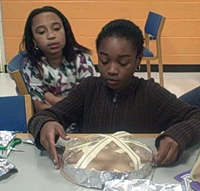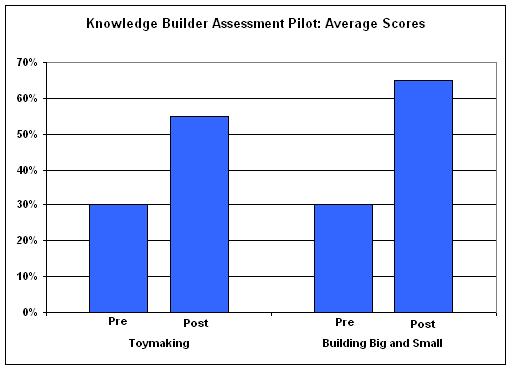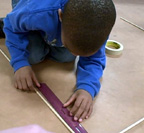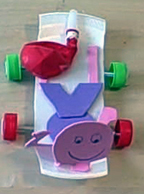Home > Programs > After-school classes
Two 8-session creative engineering modules develop skills for school and life in the 21st century:
Support school and life skills with these 8-session creative engineering modules:
At Big Learning, our overarching goals are to close the achievement gap while building 21st-century life and leadership skills, and we meet these goals through design and implementation of highly engaging, intellectually-rich hands-on curriculum and activities. We have pioneered an instructional method, Knowledge-Infused Design (KID), in which children learn knowledge and skills for school and life success while doing creative engineering and design projects.
In response to the pressing need for quality afterschool curriculum to help close the achievement gap, we have developed two Big Learning KID (formerly called Knowledge Builder) multi-session curriculum packages, Toymaking and Building Big and Small, both for children in grades 2-4. In Toymaking, students use principles of mechanical engineering to design and build artistic and whimsical toys. In Building Big and Small, students use structural engineering principles to design and build large and small structures that are colorful, creative, and useful. Both classes are supported by extensive teacher materials and training.
 Big Learning KID builds background knowledge to support reading comprehension, develops foundational concepts to support STEM success, and teaches students the skills they need to become leaders in the 21st century, including communication, collaboration, and problem solving. Big Learning KID engages children and inspires their creativity with rich and colorful project materials such as wood, wire, and foam.
Big Learning KID builds background knowledge to support reading comprehension, develops foundational concepts to support STEM success, and teaches students the skills they need to become leaders in the 21st century, including communication, collaboration, and problem solving. Big Learning KID engages children and inspires their creativity with rich and colorful project materials such as wood, wire, and foam.
KID teaching methods are best shown by describing a typical Big Learning KID session. In one particular Toymaking session, students learn about folk toys in early America (history) and around the world (geography). Then while making creative versions of two folk toys, a button spinner and a climbing animal, they learn tricks for drawing animals (art), how to draw a circle of a given radius with a compass (math), how to create a color-mixing optical illusion on a spinning disk (art and science), and why the illusion works (anatomy of the eye). In every session, the creative project serves as a focal point around which we build knowledge, vocabulary, and skills across subject areas.
Funding for portions of the development of Big Learning KID have come from the Carl M. Freeman Foundation.
 Test questions addressed both knowledge and self concept, in keeping with Big Learning KID's multiple goals. We were pleased with student gains, and revised both the curriculum and the assessments to increase the power of each.
Test questions addressed both knowledge and self concept, in keeping with Big Learning KID's multiple goals. We were pleased with student gains, and revised both the curriculum and the assessments to increase the power of each.
Big Learning KID also comes with all project materials. Teachers don't have to spend time cutting and counting; they just grab that session's materials and head to the classroom.
Big Learning KID (Knowledge-Infused Design): Learning Without Limits
A design-based curriculum for children in grades 2-4Two 8-session creative engineering modules develop skills for school and life in the 21st century:
- Toymaking: Children design and build mechanical toys based on technologies including levers, springs, and wheels.
- Building Big and Small: Children design and build structures. Half the structures are large enough to play inside of them, and half are table-top structure.
- Eco-KID: Children students study habitate design and learn techniques for designing and building living models and simulations of habitats and ecosystems.
Features of All Classes
All Big Learning KID sessions share the following features:- Immersion in multisensory learning: Color, images, and sound make learning come alive. Every session includes custom-made posters filled with real-world images germane to the day's topic. The posters serve as a discussion guide as teachers facilitate students' engagement with new concepts. Music enhances work time and create a lively atmosphere. Rich and varied materials and tools inspire students to do something special with their learning.
- Multi-age adaptability: Our workshops have been used successfully with children in grades 2-5. That's because the projects are designed so that students can build them elaborately or simply. Furthermore, the topics and background knowledge are structured so that they can be approached at any level, without prerequisites. We often teach multi-age groups, in which all the children integrate the material at their own levels while working together.
- No cookie-cutter projects: Each week we teach students a new design technology, but what they do with it is up to them. In Toymaking, for example, a propeller-type rubber-band spinner might turn into a helicopter blade for one student, while another might make a butterfly with twin spinning wings. That flexibility keeps students invested in learning, and it also offers many opportunities for individual and group problem solving as students figure out how to make their ideas work.
- Great materials and tools: We make our programs affordable without sacrificing the quality of creative materials we provide. We choose our materials carefully so students can make attractive, durable projects. We empower students with real tools they can use safely: diagonal pliers for cutting, hand-powered drills, and T-squares. Having better tools lets students work with a greater variety of materials, including wood and wire. And that adds up to learning you just can't get with a sheet of plain paper.
- Affordable: Big Learning KID is designed to be financially accessible. We've worked very hard to drive the per-student cost materials down, while keeping the projects robust and interesting. The per-student materials cost of Toymaking is about $1.25 per session for a class of 20 students on an ongoing basis. The first-time cost is higher due to the cost of the tools and reusable materials. The per-student materials cost of Building Big & Small is about $1.75 per session for a class of 20 students on an ongoing basis. As with Toymaking, the first-time cost of Building is higher due to the cost of the tools and reusable materials. There is also a one-time license fee for each product's curriculum.

Measuring builds number sense
and ease with fractions
and ease with fractions

Children lean about
Newton's laws of motion
and wheel-and-axle
assemblies
Newton's laws of motion
and wheel-and-axle
assemblies
Support school and life skills with these 8-session creative engineering modules:
At Big Learning, our overarching goals are to close the achievement gap while building 21st-century life and leadership skills, and we meet these goals through design and implementation of highly engaging, intellectually-rich hands-on curriculum and activities. We have pioneered an instructional method, Knowledge-Infused Design (KID), in which children learn knowledge and skills for school and life success while doing creative engineering and design projects.
In response to the pressing need for quality afterschool curriculum to help close the achievement gap, we have developed two Big Learning KID (formerly called Knowledge Builder) multi-session curriculum packages, Toymaking and Building Big and Small, both for children in grades 2-4. In Toymaking, students use principles of mechanical engineering to design and build artistic and whimsical toys. In Building Big and Small, students use structural engineering principles to design and build large and small structures that are colorful, creative, and useful. Both classes are supported by extensive teacher materials and training.

KID teaching methods are best shown by describing a typical Big Learning KID session. In one particular Toymaking session, students learn about folk toys in early America (history) and around the world (geography). Then while making creative versions of two folk toys, a button spinner and a climbing animal, they learn tricks for drawing animals (art), how to draw a circle of a given radius with a compass (math), how to create a color-mixing optical illusion on a spinning disk (art and science), and why the illusion works (anatomy of the eye). In every session, the creative project serves as a focal point around which we build knowledge, vocabulary, and skills across subject areas.
Funding for portions of the development of Big Learning KID have come from the Carl M. Freeman Foundation.
Everything You Need, Ready to Go
Big Learning KID is offered as a complete product for use by aftercare facilities, schools, and camps. It includes:- The curriculum
- Detailed teacher's guides, including preparation and teaching instructions
- How-to videos showing how to make each project
- Classroom posters, used during the discussion period to relate each project to the real world
- Student instruction cards, which enable the students to work more independently
- All project materials and tools
- Take-home sheets for each project, which lets parents know what their children did during that Big Learning session, and also includes relevant resources parents can use if their child wants to do similar projects at home
- Teacher training
The real world is the starting
point for every project
point for every project
Features of All Classes
All Big Learning KID sessions share the following features:- Immersion in multisensory learning: Color, images, and sound make learning come alive. Every session includes custom-made posters filled with real-world images germane to the day's topic. The posters serve as a discussion guide as teachers facilitate students' engagement with new concepts. Music enhances work time and create a lively atmosphere. Rich and varied materials and tools inspire students to do something special with their learning.
- Multi-age adaptability: Our workshops have been used successfully with children in grades 2-5. That's because the projects are designed so that students can build them elaborately or simply. Furthermore, the topics and background knowledge are structured so that they can be approached at any level, without prerequisites. We often teach multi-age groups, in which all the children integrate the material at their own levels while working together.
- No cookie-cutter projects: Each week we teach students a new design technology, but what they do with it is up to them. In Toymaking, for example, a propeller-type rubber-band spinner might turn into a helicopter blade for one student, while another might make a butterfly with twin spinning wings. That flexibility keeps students invested in learning, and it also offers many opportunities for individual and group problem solving as students figure out how to make their ideas work.
- Great materials and tools: We make our programs affordable without sacrificing the quality of creative materials we provide. We choose our materials carefully so students can make attractive, durable projects. We empower students with real tools they can use safely: diagonal pliers for cutting, hand-powered drills, and T-squares. Having better tools lets students work with a greater variety of materials, including wood and wire. And that adds up to learning you just can't get with a sheet of plain paper.
- Affordable: Big Learning KID is designed to be financially accessible. We've worked very hard to drive the per-student cost materials down, while keeping the projects robust and interesting. The per-student materials cost of Toymaking is about $1.25 per session for a class of 20 students on an ongoing basis. The first-time cost is higher due to the cost of the tools and reusable materials. The per-student materials cost of Building Big & Small is about $1.75 per session for a class of 20 students on an ongoing basis. As with Toymaking, the first-time cost of Building is higher due to the cost of the tools and reusable materials. There is also a one-time license fee for each product's curriculum.

Measuring builds number sense
and ease with fractions
and ease with fractions

Children lean about
Newton's laws of motion
and wheel-and-axle
assemblies
Newton's laws of motion
and wheel-and-axle
assemblies
Great Results
Assessment of Big Learning KID is ongoing. Initial assessments have tested students on their prior knowledge of the concepts covered in our classes, and then retested them after the class, a standard pre-post evaluation technique. 
Research-based
Big Learning KID is based on a long history of research showing the importance of background knowledge and vocabulary for virtually all kinds of academic achievement, including reading comprehension, mathematical concept development, and scientific literacy. Every class is packed with real-world knowledge. For example, in our session on folk toys, students learn about toys in early America (history). Then they make creative versions of two folk toys – a button spinner and a climbing animal. In the process, they learn tricks for drawing animals (art), how to draw a circle of a given radius with a compass (math), how to create a color-mixing optical illusion on a spinning disk (art and science), and why the illusion works (anatomy of the eye). Every session is like that – the engineering project serves as a focal point around which we build knowledge, vocabulary, and skills across subject areas, including math, science,language, history, and art.
Designed for Busy Teachers
We know that teachers are busy, so Big Learning KID is organized to minimize their prep time, and maximize their teaching effort. The teacher's guide contains the information they need to prepare for, as well as teach, the class. For each class session, the teacher's guide includes:- An overview of the academic concepts included in that session
- A description of the classroom posters, and suggestions on how to use them to relate that session's projects to the real world during the discussion period
- Detailed, step-by-step instructions, with pictures, of how to build each project, for use by the teacher before class
- A higher-level description of how to build each project, for use by the teacher during class, if necessary
Big Learning KID also comes with all project materials. Teachers don't have to spend time cutting and counting; they just grab that session's materials and head to the classroom.


